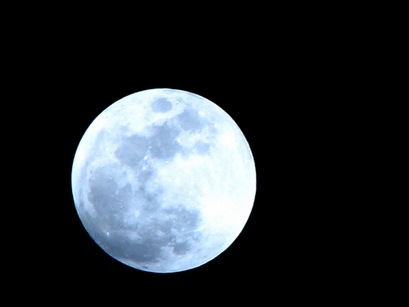
Staff Writer
SPACE.com
Scientists are priming two spacecraft to slam into the moon's South Pole to see if the lunar double whammy reveals hidden water ice.
The Earth-on-moon violence may raise eyebrows, but NASA's history shows that such missions can yield extremely useful scientific observations.
"I think that people are apprehensive about it because it seems violent or crude, but it's very economical," said Tony Colaprete, the principal investigator for the mission at NASA's Ames Research Center in Moffett Field, Calif.
NASA's previous Lunar Prospector mission detected large amounts of hydrogen at the moon's poles before crashing itself into a crater at the lunar South Pole. Now the much larger Lunar Crater and Observation Sensing Satellite (LCROSS) mission, set for a February 2009 moon crash, will take aim and discover whether some of that hydrogen is locked away in the form of frozen water.
LCROSS will piggyback on the Lunar Reconnaissance Orbiter (LRO) mission for an Oct. 28 launch atop an Atlas 5 rocket equipped with a Centaur upper stage. While the launch will ferry LRO to the moon in about four days, LCROSS is in for a three-month journey to reach its proper moon smashing position. Once within range, the Centaur upper stage doubles as the main 4,400 pound (2,000 kg) impactor spacecraft for LCROSS.
The smaller Shepherding Spacecraft will guide Centaur towards its target crater, before dropping back to watch - and later fly through - the plume of moon dust and debris kicked up by Centaur's impact. The shepherding vehicle is packed with a light photometer, a visible light camera and four infrared cameras to study the Centaur's lunar plume before it turns itself into a second impactor and strikes a different crater about four minutes later.
"This payload delivery represents a new way of doing business for the center and the agency in general," said Daniel Andrews, LCROSS project manager at Ames, in a statement. "LCROSS primarily is using commercial-off-the-shelf instruments on this mission to meet the mission's accelerated development schedule and cost restraints."
Figuring out the final destinations for the $79 million LCROSS mission is "like trying to drive to San Francisco and not knowing where it is on the map," Colaprete said. He and other mission scientists hope to use observations from LRO and the Japanese Kaguya (Selene) lunar orbiter to map crater locations before LCROSS dives in.
"Nobody has ever been to the poles of the moon, and there are very unique craters - similar to Mercury - where sunlight doesn't reach the bottom," Colaprete said. Earth-based radar has also helped illuminate some permanently shadowed craters. By the time LCROSS arrives, it can zero in on its 19 mile (30 km) wide targets within 328 feet (100 meters).
Scientists want the impactor spacecraft to hit smooth, flat areas away from large rocks, which would ideally allow the impact plume to rise up out of the crater shadows into sunlight. That in turn lets LRO and Earth-based telescopes see the results.
"By understanding what's in these craters, we're examining a fossil record of the early solar system and would occurred at Earth 3 billion years ago," Colaprete said. LCROSS is currently aiming at target craters Faustini and Shoemaker, which Colaprete likened to "fantastic time capsules" at 3 billion and 3.5 billion years old.
LCROSS researchers anticipate a more than a 90 percent chance that the impactors will find some form of hydrogen at the poles. The off-chance exists that the impactors will hit a newer crater that lacks water - yet scientists can learn about the distribution of hydrogen either way.
"We take [what we learn] to the next step, whether it's rovers or more impactors," Colaprete said.
This comes as the latest mission to apply brute force to science.
The Deep Impact mission made history in 2005 by sending a probe crashing into comet Tempel 1. Besides Lunar Prospector's grazing strike on the moon in 1999, the European Space Agency's Smart-1 satellite dove more recently into the lunar surface in 2006.
LCROSS will take a much more head-on approach than either Lunar Prospector or Smart-1, slamming into the moon's craters at a steep angle while traveling with greater mass at 1.6 miles per second (2.5 km/s). The overall energy of the impact will equal 100 times that of Lunar Prospector and kick up 1,102 tons of debris and dust.
"It's a cost-effective, relatively low-risk way of doing initial exploration," Colaprete said, comparing the mission's approach to mountain prospectors who used crude sticks of dynamite to blow up gully walls and sift for gold. Scientists are discussing similar missions for exploring asteroids and planets such as Mars.
Nevertheless, Colaprete said they "may want to touch the moon a bit more softly" after LCROSS has its day.
http://www.space.com/php/video/player.php?video_id=b050628_di_sm
http://www.space.com/php/multimedia/imagegallery/igviewer.php?imgid=4206&gid=302&index=0
http://www.space.com/php/video/player.php?video_id=240907_Moon2_Google
Original Story:
http://www.space.com/businesstechnology/080227-techwed-lcross-moon-smasher.html

No comments:
Post a Comment